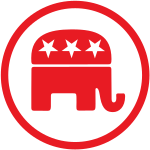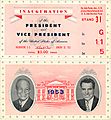History of the Republican Party (United States) facts for kids
Quick facts for kids
Republican Party
|
|
|---|---|
 |
|
| Other name | National Union Party |
| Founders | Amos Tuck Alvan E. Bovay |
| Founded | March 20, 1854 Ripon, Wisconsin, U.S. |
| Preceded by | Liberty Party Conscience Whigs Free Soil Party Anti-Nebraska movement North American Party |
| Headquarters | 310 First Street SE, Washington, D.C., 20003 |
| Membership | |
| Ideology | American conservatism |
| Colors | Red (since 2000) |
| Website | |
| gop.com | |
The Republican Party, also known as the GOP (Grand Old Party), is one of the two main political parties in the United States. It is the second-oldest political party in the U.S., after the Democratic Party.
Contents
History of the Republican Party
Before the Civil War, the Whigs and Democrats were the main political groups. In 1854, a law called the Kansas–Nebraska Act was passed. This law allowed new territories like Kansas and Nebraska to decide if they would allow slavery. This made many people upset.
People who were against slavery, including former Whigs and members of the Free Soil Party, came together. They met in a schoolhouse in Ripon, Wisconsin, on March 20, 1854. Here, they suggested "Republican" as the name for a new anti-slavery party. The first big meeting to officially form the party and choose candidates happened on July 6, 1854, near Jackson, Michigan.
Early Goals and Beliefs
The new Republican Party wanted to modernize the United States. They supported more banks, railroads, and factories. They also wanted to give free land in the West to farmers. This was different from letting slave owners buy up the best land.
The party strongly believed that working for pay was better than slavery. They thought it was the basis of a good society. Their main idea was "Free Soil, Free Labor, Free Men." This meant they wanted new territories to be free from slavery. They also wanted people to be free to work for themselves. In the 1850s, the Republican Party aimed to stop slavery from spreading.
First National Steps
The Republican Party held its first national meeting in Pittsburgh, Pennsylvania, on February 22, 1856. Their first meeting to choose a presidential candidate was in June 1856 in Philadelphia. John C. Frémont was their first candidate for president in 1856. His slogan was "Free soil, free silver, free men, Frémont and victory!"
Even though Frémont did not win, the party showed it had strong support. They were very popular in New England, New York, and the northern Midwest. They had almost no support in the Southern states.
Who Supported the Early Republicans?
The early Republican Party was made up of northern Protestants, factory workers, and business people. Prosperous farmers also supported them. After the Civil War, former black slaves joined the party.
The party had very little support from white Southerners. Most white Southerners supported the Democratic Party. Catholics also tended to vote Democratic. Before 1861, the Republican Party was against the spread of slavery. They then led the fight to defeat the Confederate States of America during the Civil War.
Lincoln and Civil War Era
Abraham Lincoln became president in 1860. His election began a new era of Republican power. This power was based in the industrial North and farming Midwest. Lincoln was very successful at uniting his party to fight for the Union in the Civil War.
During the war, the party passed important laws in Congress. These laws helped the country modernize quickly. They included a national banking system and high taxes on imported goods. They also introduced the first temporary income tax. The party also passed laws for homesteads, railroads, and aid for education and farming.
In 1864, the Republicans joined with some Democrats who supported the war. They formed the National Union Party. Lincoln chose Democrat Andrew Johnson as his running mate. Lincoln was easily re-elected. The Republican Party was the main political force in the U.S. until 1932.
Changes in the 20th Century
In 1912, former Republican president Theodore Roosevelt left the party. He formed the Progressive ("Bull Moose") Party. He ran for president again but did not win. After 1912, many of Roosevelt's supporters left the Republican Party. The party then became more conservative.
The Republican Party lost its majority in Congress during the Great Depression (1929–1940). Under President Franklin D. Roosevelt, the Democrats formed a strong group called the New Deal coalition. This group was powerful from 1932 to 1964.
After the Civil Rights Act of 1964 and the Voting Rights Act of 1965, the party's main supporters changed. Southern states started to vote more for Republicans in presidential elections. Northeastern states began to vote more for Democrats. White voters increasingly supported the Republican Party after the 1960s.
Modern Republican Party
The Republican Party won five out of six presidential elections from 1968 to 1988. Ronald Reagan was president from 1981 to 1989. He was a very important leader for the party. His conservative policies called for less government spending on social programs. He also wanted fewer rules for businesses and more military spending. Reagan also supported lower taxes and a strong stance against the Soviet Union. His ideas continued to influence the party for many years.
Since the 1990s, the party's support has mainly come from the South, the Great Plains, the Mountain States, and rural areas in the North. Today, the party supports free market economics and social conservatism. They also believe in interpreting the Constitution based on its original meaning. There have been 19 Republican presidents, which is more than any other political party.
Images for kids
-
Birthplace of the Republican Party at a schoolhouse, in Ripon, Wisconsin
-
Musical Fund Hall at 808 Locust Street in Center City Philadelphia, where the first Republican nominating convention for president and vice president was held from June 17 to 19, 1856
-
African-American members of the United States Senate and the United States House of Representatives: Sen. Hiram Revels (R-MS) and Reps. Benjamin Turner (R-AL), Robert DeLarge (R-SC), Josiah Walls (R-FL), Jefferson Long (R-GA), Joseph Rainey and Robert B. Elliott (R-SC), 1872
-
Ulysses S. Grant was the first Republican president to serve for two full terms (1869–1877)
-
Theodore Roosevelt leads party to landslide win in 1904
-
Dwight D. Eisenhower and Richard Nixon, 1953: the first Republican presidential inauguration in 24 years
-
Ronald Reagan launched the "Reagan Revolution" with his election to the presidency in 1980, providing conservative influence that continues to the present day
-
Newt Gingrich, House Speaker (1995–1999), was a visible leader against President Bill Clinton
-
The presidency of George W. Bush was greatly impacted by the events of the September 11th terrorist attacks
-
John Boehner, House Speaker (2011–2015), was a visible leader against President Barack Obama
-
Donald Trump, 45th President of the United States














